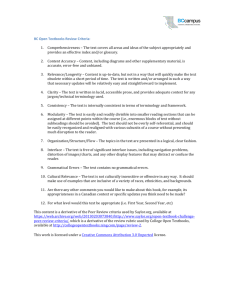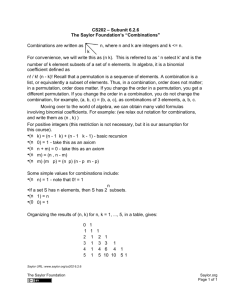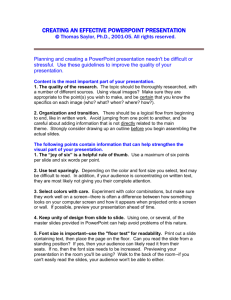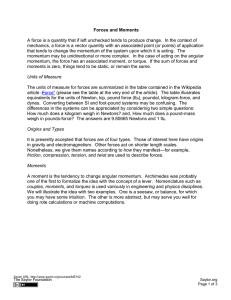Introduction to Mathematical Reasoning, Saylor 111 Counting
advertisement
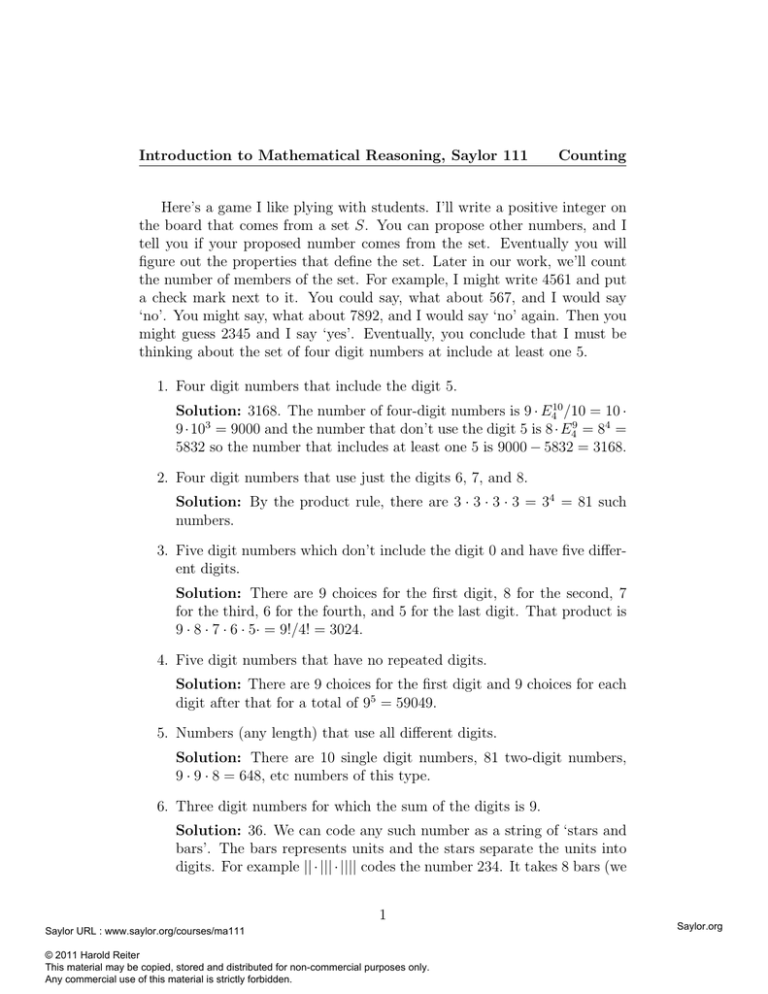
Introduction to Mathematical Reasoning, Saylor 111
Counting
Here’s a game I like plying with students. I’ll write a positive integer on
the board that comes from a set S. You can propose other numbers, and I
tell you if your proposed number comes from the set. Eventually you will
figure out the properties that define the set. Later in our work, we’ll count
the number of members of the set. For example, I might write 4561 and put
a check mark next to it. You could say, what about 567, and I would say
‘no’. You might say, what about 7892, and I would say ‘no’ again. Then you
might guess 2345 and I say ‘yes’. Eventually, you conclude that I must be
thinking about the set of four digit numbers at include at least one 5.
1. Four digit numbers that include the digit 5.
Solution: 3168. The number of four-digit numbers is 9 · E410 /10 = 10 ·
9 · 103 = 9000 and the number that don’t use the digit 5 is 8 · E49 = 84 =
5832 so the number that includes at least one 5 is 9000 − 5832 = 3168.
2. Four digit numbers that use just the digits 6, 7, and 8.
Solution: By the product rule, there are 3 · 3 · 3 · 3 = 34 = 81 such
numbers.
3. Five digit numbers which don’t include the digit 0 and have five different digits.
Solution: There are 9 choices for the first digit, 8 for the second, 7
for the third, 6 for the fourth, and 5 for the last digit. That product is
9 · 8 · 7 · 6 · 5· = 9!/4! = 3024.
4. Five digit numbers that have no repeated digits.
Solution: There are 9 choices for the first digit and 9 choices for each
digit after that for a total of 95 = 59049.
5. Numbers (any length) that use all different digits.
Solution: There are 10 single digit numbers, 81 two-digit numbers,
9 · 9 · 8 = 648, etc numbers of this type.
6. Three digit numbers for which the sum of the digits is 9.
Solution: 36. We can code any such number as a string of ‘stars and
bars’. The bars represents units and the stars separate the units into
digits. For example || · ||| · |||| codes the number 234. It takes 8 bars (we
1
Saylor URL : www.saylor.org/courses/ma111
© 2011 Harold Reiter
This material may be copied, stored and distributed for non-commercial purposes only.
Any commercial use of this material is strictly forbidden.
Saylor.org
Introduction to Mathematical Reasoning, Saylor 111
Counting
have to leave at least one bar at the left end) and 2 stars to code this
number.
¡10¢ Therefore the number of three digit numbers n with S(n) = 9
is 2 = 45.
7. Four digit numbers for which the digits increase from left to right,
sometimes called rising numbers.
Solution: 126. Each four element set gives rise to such a rising number,
and the correspondence is 1-1. In other words each four element
¡9¢ subset
gives rise to exactly one rising number. There are therefore 4 = 126
such numbers.
8. Four digit numbers for which the numbers do not decrease, sometimes
called non-decreasing numbers.
Solution: 495. This is similar except that repetition is allowed. Each
four element multiset gives rise to such a non-decreasing number, and
the correspondence is 1-1. In other words each four element multisubset
of {1, 2, . . . , 9} gives¡ rise to
¢ exactly one non-decreasing number. There
are therefore Y49 = 9+4−1
= 495 such numbers.
4
9. Six digit numbers a1 a2 a3 a4 a5 a6 that use just the digits 1 through 6, each
just once and satisfy the requirement a1 < a2 > a3 < a4 > a5 < a6 .
These are called up-down numbers.
Solution: We need to develop some notation to solve this hard problem. Let U (n) denote the number of ways to arrange the numbers
from 1 to n in up-down fashion. The number D(n) is the number
of ways to arrange these numbers in down-up fashion. Of course
U (n) = D(n). Now U (2) = 1 and U (3) = |{132, 231}| = 2, and
U (4) = |{1423, 1324, 2413, 2314, 3412}| = 5. To compute U (6), as yourself where the 6 can go among the digits. It must go in the second,
fourth, or sixth place. We’ll consider each of the three cases. Reasoning
as below, we can see that U (5) = 16.
¡¢
6 in position 2 . There are 54 = 5 ways to pick the digits that will go in positions
three through six, and then U (4) = 5 ways to arrange them. So
there are 5 · 5 = 25 numbers in this case. An example is 463512.
¡¢
6 in position 4 . There are 53 = 10 ways to pick the digits to go in the first
three positions, and U (3) = 2 ways to arrange them once they are
2
Saylor URL : www.saylor.org/courses/ma111
© 2011 Harold Reiter
This material may be copied, stored and distributed for non-commercial purposes only.
Any commercial use of this material is strictly forbidden.
Saylor.org
Introduction to Mathematical Reasoning, Saylor 111
Counting
selected. The numbers in positions five and six are determined, so
there are 10 · 2 = 20 numbers in this case. An example is 142635.
6 in position 6 . There are U (5) = 16 ways to arrange the numbers from 1 to 5
in up-down fashion. An example is given by 152436.
Taking the sum of the three cases, we have 25 + 20 + 16 = 61 up-down
arrangements of the digits 1 through 6. IE, U (6) = 61. Amazingly, the
value of the 6th derivative of the secant function at zero is 61 also, and
this is not a coincidence. See
http://www.math.uncc.edu/ hbreiter/m6105/snakes.pdf
for details.
We’re going to start with some easier problems. For convenience we are
discussing numbers that can be built without the digit 0. In other words, we
can use only digits from D = {1, 2, 3, 4, 5, 6, 7, 8, 9}. These items are counted
in the chart below.
1. How many four-digit number are there?
2. How many four-digit numbers have four different digits?
3. How many four-element subsets does the nine-element set D = {1, 2, 3, 4, 5, 6, 7, 8, 9}
have? Alternatively, how many four-digit increasing numbers are there?
4. How many how many four-digit non-decreasing numbers are there?
¡ ¢
n!
.
Throughout we use both the notations nr and Crn for the number (n−r)!r!
We are ready to discuss the general idea of counting samples taken from a
population of objects. In doing such sampling we are allowed to make a
distinction between the order in which the objects became a part of the
sample or not. We are also allowed to sample with replacement or not.
This leads to four different types of samples. If we count as different two
samples that have the same elements but in a different order, we call these
arrangements, and if we don’t distinguish on this basis, we call the samples
selections. Let’s classify each of the counting problems above using these two
questions.
3
Saylor URL : www.saylor.org/courses/ma111
© 2011 Harold Reiter
This material may be copied, stored and distributed for non-commercial purposes only.
Any commercial use of this material is strictly forbidden.
Saylor.org
Introduction to Mathematical Reasoning, Saylor 111
Counting
order matters
order does not matter
arrangements()
selections{}
with repetitions
Exponations
Yahtzee Rolls
¡
¢
Ern = nr
Y¡rn = C¢rn+r−1 = n+r−1
r
all 94 = 6561
all 9+4−1
= 495 four-digit
4
four-digit numbers
nondecreasing numbers
without repetitions
Permutations
Combinations¡ ¢
n!
n!
n
n
= nr
Pr = (n−r)!
Cr = (n−r)!r!
¡
¢
all P49 = 9!/5! = 3024 four-digit
all 94 = 126 four-digit
numbers with four different digits
increasing numbers
4
Saylor URL : www.saylor.org/courses/ma111
© 2011 Harold Reiter
This material may be copied, stored and distributed for non-commercial purposes only.
Any commercial use of this material is strictly forbidden.
Saylor.org
Introduction to Mathematical Reasoning, Saylor 111
Counting
1. (1998 state math contest) There are 8 girls and 6 boys in the Math
Club at Central High School. The Club needs to form a delegation to
send to a conference, and the delegation must contain exactly two girls
and two boys. How many delegations that can be formed?
¡8¢
Solution: 420.
The
two
girls
can
be
picked
in
= 28 ways and the
2
¡6¢
two boys in 2 = 15 ways. The product is 28 · 15 = 420.
2. (1998 state math contest) Given n a positive integer, a plus or minus
sign is assigned randomly to each of the integers 1, 2, . . . , n. Let P (n)
be the probability that the sum of the n signed numbers is positive.
What is the value of [P (1) + P (2) + · · · + P (6)]?
Solution: 45/16. Note that P (1) = P (2) = P (5) = P (6) = 1/2
because the probability that the signed sum is zero must be 0 in each
of those cases, and getting a positive sum is just as likely as getting
a negative sum. In the other cases, P (3) and P (4), a signed sum of
0 is possible: −1 − 1 + 3 = 1 + 2 − 3 = 0, so the probability that
the signed sum is positive is P (3) = 21 (1 − 82 ) = 83 . In the P (4) case,
2
7
) = 16
. Thus the
−1 + 2 + 3 − 4 = 1 − 2 − 3 + 4 = 0, so P (4) = 21 (1 − 16
45
sum is 16 .
3. (1999 state math contest) A box contains b red, 2b white and 3b blue
balls, where b is a positive integer. Three balls are selected at random
and without replacement from the box. Let p(b) denote the probability
that no two of the selected balls have the same color. Is there a value
of b for which p(b) = 1/6?
Solution: No. Note that
=
p(b) = 1−the probability that all three colors are different = 1− b·2b·3b
(6b3 )
6b3 ·6
6b2
= 1 − (6b−1)(6b−2)
. Setting this quantity equal to 1/6
1 − 6b·(6b−1)(6b−2)
and massaging get the quadratic 144b2 − 90b + 10 which has a discriminant that is not a perfect square. Thus, there is no b for which
p(b) = 1/6.
4. (2009 Mathcounts) Four points A, B, C and D on one line segment are
jointed by line segments to each of five points E, F, G, H, and I on a
second line segment. What is the maximum number of points interior
to the angle belonging to two of these twenty segments.
5
Saylor URL : www.saylor.org/courses/ma111
© 2011 Harold Reiter
This material may be copied, stored and distributed for non-commercial purposes only.
Any commercial use of this material is strictly forbidden.
Saylor.org
Introduction to Mathematical Reasoning, Saylor 111
Counting
I
.......
.
.
H
.
.
.
.
.
.....
G
........
.
.
.
F
.
.
.
.
.....
E
........
.
.
.
.
.
.
.
....
A B C D
Solution: Each point of intersection is determined by a taking a pair
from¡ the
¢ ¡set
¢ {A, B, C, D} and a pair from the set {E, F, G, H, I}. There
4
5
are 2 · 2 = 6 · 10 = 60 such points.
5. (Mathcounts 2009) How many three-digit numbers can be built from
the digits in the list 2, 3, 5, 5, 5, 6, 6?
Solution: 43.
6. A falling number is an integer whose decimal representation has the
property that each digit except the units digit is larger than the one to
its right. For example, 96520 is a falling number but 89642 is not. How
many five-digit falling numbers are there? How many n-digit falling
numbers are there, for n = 1, 2, 3, 4, 5, 6, 7, 8, and 9? What is the total
number of falling numbers of all sizes?
Solution: Each set of k digits can be arranged in exactly one way to
form a falling number. Thus, there are just as many k-digit falling numbers
¡10¢¡as
¢there
¡10¢ are
¡10¢k-member subsets of {0, 1, 2, 3, 4, 5, 6, 7, 8, 9}. That is,
10
,
, 4 ,
1 ¢ 2 ¡ 3¢
¡10
10
, ..., 10 . Adding all these numbers together gives 210 − 1 = 1023,
5
since we don’t count numbers with zero digits.
¡¢
7. Cyprian writes down the middle number in each of the 95 = 126 fiveelement subsets of S = {1, 2, 3, 4, 5, 6, 7, 8, 9}. Then he adds all these
numbers together. What sum does he get?
6
Saylor URL : www.saylor.org/courses/ma111
© 2011 Harold Reiter
This material may be copied, stored and distributed for non-commercial purposes only.
Any commercial use of this material is strictly forbidden.
Saylor.org
Introduction to Mathematical Reasoning, Saylor 111
Counting
¡6¢
¡3¢ ¡5¢
¡4¢ ¡4¢
¡5¢ ¡3¢
¡6¢
Solution:
He
gets
3
·
+
4
·
·
+
5
·
·
+
6
·
·
+
7
·
·
2
2
2
2
2
2
2
2
¡2¢
= 45 + 120 + 180 + 180 + 105 = 630. Alternatively, there is a 1-1
2
correspondence between the five-element subsets with middle value k
and those with middle value 10¡ −
¢ k, so the average value of the middle
number is 5. Since there are 95 = 126 five-element subsets, the sum
Cyprian gets is 5 · 126 = 630. An example of the 1-1 correspondence is
given below: {1, 3, 6, 7, 8} ⇔ {2, 3, 4, 7, 9} = {10 − 8, 10 − 7, 10 − 6, 10 −
3, 10 − 1}.
8. Counting sums of subset members.
(a) How many numbers can be expressed as a sum of two or more
distinct members of the set {1, 2, 3, 4, 5, 6, 7, 8, 9}?
Solution: The sums are not distinct. However the numbers we
can get are consecutive integers. The smallest is 1 + 2 = 3 and
the largest is 1 + 2 + 3 + 4 + 5 + 6 + 7 + 8 + 9 = 45, so there are
45 − 2 = 43 such numbers.
(b) How many integers can be expressed as a sum of two or more
different members of the set {0, 1, 2, 4, 8, 16, 32}?
Solution: The 0 in the set means that we should count the
individual elements among the sums. Every number from 1 and
63 has a unique representation (its binary representation) as a sum
of powers of 2. The powers of 2 themselves can be represented as
a sum because of the 0 in the set. Thus the answer is 63.
7
Saylor URL : www.saylor.org/courses/ma111
© 2011 Harold Reiter
This material may be copied, stored and distributed for non-commercial purposes only.
Any commercial use of this material is strictly forbidden.
Saylor.org
Introduction to Mathematical Reasoning, Saylor 111
Counting
(c) How many numbers can be expressed as a sum of four distinct
members of the set {17, 21, 25, 29, 33, 37, 41}?
Solution: Each member of {17, 21, 25, 29, 33, 37, 41} is one more
than a multiple of four. Therefore, any sum of four of them is a
multiple of 4. The smallest such number is 17 + 21 + 25 + 29 = 92
and the largest is 29 + 33 + 37 + 41 = 140 and all the multiples of 4
+ 1 = 48
+ 1 = 13
between them are obtainable. There are 140−92
4
4
such numbers.
Alternatively, we transform the problem into a simpler one. Because 17 = 4 · 4 + 1, 21 = 4 · 5 + 1, . . . , 41 = 4 · 10 + 1, it makes
sense to set up a correspondence between the set of sums R and
the set of numbers generated by {4, 5, 6, 7, 8, 9, 10} OR between
R and those numbers generated by {−3, −2, −1, 0, 1, 2, 3}. The
set R in this case is just {−6, −5, −4, −3, −2, −1, 0, 1, 2, 3, 4, 5, 6},
which has 13 members.
(d) How many numbers can be expressed as a sum of two or more
distinct members of the set {17, 21, 25, 29, 33, 37, 41}?
Solution: Let A, B, C, D, E, F denote the sets of numbers that
can be written as a sum of 2, 3, 4, 5, 6, 7 members of the set respectively. We counted C above. Counting the others yields
|A| = 11, |B| = 13, |C| = 13, |D| = 11, |E| = 7 and |F | = 1.
But what about the overlap? There is none! Why? So the total
is 11 + 13 + 13 + 11 + 7 + 1 = 56 .
(e) How many integers can be expressed as a sum of two or more
distinct elements of the set {1, −3, 9, −27, 81, −243}?
Solution: An equivalent question is How many numbers have
base −3 representations that have at most six digits all of which
are 1’s and 0’s? The answer to the second question is 7 more than
the answer to the first one however, because of the requirement
that we must add two or more of the powers of −3. There are
26 = 64 such six-digit numbers, so the answer to our question is
64 − 7 = 57.
9. How many of the first 242 positive integers are expressible as a sum of
three or fewer members of the set {30 , 31 , 32 , 33 , 34 } if we are allowed
to use the same power more than once? For example, 5 = 3 + 1 +
1 can be represented, but 8 cannot. Hint: think about the ternary
8
Saylor URL : www.saylor.org/courses/ma111
© 2011 Harold Reiter
This material may be copied, stored and distributed for non-commercial purposes only.
Any commercial use of this material is strictly forbidden.
Saylor.org
Introduction to Mathematical Reasoning, Saylor 111
Counting
representations.
Solution: The number of powers of 3 used is just the sum of the
ternary digits. We are looking for the number of integers whose ternary
representations have a sum of digits of 3 or less. We consider three
types, those with sum of digits 1, 2 and 3. There
¡5¢just 5 with sum
¡5¢ are
of digits 1: 10000, 1000, 100, 10, 1. There are 2 + 1 = 10 + 5 = 15
numbers with sum of digits 2. There
¡5¢ are 5two types, those with two 1’s
and those with one 2. There are 3 + P2 = 10 + 20 = 30 of the third
type for a total of 5 + 15 + 30 = 50 numbers altogether.
10. John has 2 pennies, 3 nickels, 2 dimes, 3 quarters, and 8 dollars. For
how many different amounts can John make an exact purchase (with
no change required)?
Solution: We’ll count achievable amounts less than $1, and multiply
by 9, then add in the 9 values 9.00, 9.01, 9.02, 9.05, 9.06, 9.07, 9.10, 9.11, 9.12.
They are {0, 1, 2, 5, 6, 7, 10, 11, 12, . . .}, exactly three of every five consecutive values. So, counting 0, there are 53 (100) = 60 such values.
Hence there are 9 × 60 − 1 = 539, since we don’t count the value 0.
Now adding in the nine uncounted values, we get 539 + 9 = 548.
11. How many positive integers less than 1000 have an odd number of
positive integer divisors?
Solution: An integer has an odd number of divisors precisely when it is
a perfect square, and there are 31 of these in the range 1, 2, 3, . . . , 1000.
12. (2004 AMC 10 and extensions) An 8 × 10 grid of squares with one
shaded square is given.
..............
.......
(a) How many different squares are bounded by the gridlines?
Solution: This is just 10·8+9·7+8·6+7·5+6·4+5·3+4·2+3·1 =
276 .
9
Saylor URL : www.saylor.org/courses/ma111
© 2011 Harold Reiter
This material may be copied, stored and distributed for non-commercial purposes only.
Any commercial use of this material is strictly forbidden.
Saylor.org
Introduction to Mathematical Reasoning, Saylor 111
Counting
(b) How many different rectangles are bounded by the gridlines?
Solution: The idea we discussed
in class of choosing the top
¡9¢
and bottom boundaries
in 2 = 36 ways and the left and right
¡11¢
boundaries in 2 = 55 ways for a total of 36 · 55 = 1980.
(c) (∗)How many different squares bounded by the gridlines contain
the shaded square?
Solution: The answer is 27. Counting by size and starting with
the 1 × 1, we have 1 + 4 + 4 + 4 + 4 + 4 + 4 + 2 = 27.
(d) How many different rectangles bounded by the gridlines contain
the shaded square?
Solution: There are just two ways to pick the lower boundary
and two ways to pick the left boundary. There are 9 ways to pick
the right boundary and 7 ways to pick the top boundary. Their
product is 252.
13. How many squares in the plane have two or more vertices in the set
S = (0, 0), (0, 1), (0, 2), (1, 0), (1, 1), (2, 0)?
Solution: One way to do this is to determine the number of each
size. By possible areas of the squares are 1/2, 1, 2, 5/2, 4, 5 and 8 and
there are, respectively, 6,
¡67,
¢ 6, 2, 3, 4, and 2 of these for a total of 30.
Alternatively, there are 2 = 15 pairs of points, each of which could
give rise to as many as 3 squares. Since one square has all four of its
vertices in the grid, this overcounts by 5, and there are 5 squares with
three vertices in the grid, each of which leads to overcounts by 2 for a
total of 5 + 10 = 15. Thus there are 45 − 15 = 30 squares. There is yet
another method: start with two points and count the squares: 3. Add
a third point and count the new squares, then add a fourth point and
count the new ones.
14. Numbers with a given digit sum.
(a) How many numbers in the set {100, 101, 102, . . . , 999} have a sum
of digits equal to 9?
Solution: Insert two dividers into a string of 8 counters to code
such a three digit number. For example ||¡¦ |||
¢ ¦ ||| is a coding for
333 and ¦ ¦ |||||||| codes 108. There are 10
= 45 ways to code
2
such a number.
10
Saylor URL : www.saylor.org/courses/ma111
© 2011 Harold Reiter
This material may be copied, stored and distributed for non-commercial purposes only.
Any commercial use of this material is strictly forbidden.
Saylor.org
Introduction to Mathematical Reasoning, Saylor 111
Counting
(b) How many four digit numbers have a sum of digits 9?
¡ ¢
Solution: For four digit numbers, we get 11
= 165.
3
(c) How many integers less than one million have a sum of digits equal
to 9?
Solution: These number are all at most 6 digits, so insert 5
dividers in a string of 9 vertical bars. For¡ example
¦ ¦ ||| ¦ || ¦ ¦||||
¢
14
represents the number 3204. There are 9 = 2002 ways to pick
the 9 positions from the 14 locations.
15. (2008 state math contest) Two coins are removed randomly and without
replacement from a box containing 3 nickels, 2 dimes, and 1 coin of
value 0. What is the probability that one of the removed coins is worth
five cents more than the other?
Solution: ¡There
are six coins which we can label as N1 , N2 , N3 ,¡D¢¡
1, D
¢
¢ 2 , Z.
6
3 2
There
¡3¢¡1¢ are 2 = 15 ways to choose a pair of these coins, and 1 1 +
= 6 + 3 ways to be successful, so the probability is 9/15 = 3/5.
1 1
16. (2008 state math contest) A palindrome on the alphabet {H, T } is a
sequence of h’s and T ’s which reads the same from left to right as
from right to left. Thus HT H, HT T H, HT HT H and HT HHT H are
palindromes of lengths 3,4,5, and 6 respectively. Let P (n) denote the
number of palindromes of length n over {H, T }. For how many values
of n is 1000 < P (n) < 10000?
Solution: 8. The number of palindromes of length n is given by 2b
so P (n) satisfies the inequality for n = 19, 20, . . . , 26.
n+1
c
2
,
17. An urn contains marbles of four colors: red, white, blue, and green.
When four marbles are drawn without replacement, the following events
are equally likely:
(a) the selection of four red marbles;
(b) the selection of one white and three red marbles;
(c) the selection of one white, one blue, and two red marbles; and
(d) the selection of one marble of each color.
What is the smallest number of marbles that the urn could contain?
11
Saylor URL : www.saylor.org/courses/ma111
© 2011 Harold Reiter
This material may be copied, stored and distributed for non-commercial purposes only.
Any commercial use of this material is strictly forbidden.
Saylor.org
Introduction to Mathematical Reasoning, Saylor 111
Counting
Solution: 21. The hypothesis of equally likely events can be expressed
as
µ ¶µ ¶
µ ¶µ ¶µ ¶
µ ¶µ ¶µ ¶µ ¶
µ ¶
r
w
r
w
b
r
w
b
g
r
3
1
2
1
1
1
1
1 1
4
µ ¶= µ ¶ =
µ ¶
µ ¶
=
n
n
n
n
4
4
4
4
where r, w, b, and g denote the number of red, white, blue, and green
marbles, respectively, and n = r + w + b + g. Eliminating common
terms and solving for r in terms of w, b, and g, we get
r − 3 = 4w,
r − 2 = 3b,
and r − 1 = 2g.
The smallest r for which w, b, and g are all positive integers is r = 11,
with corresponding values w = 2, b = 3, and g = 5. So the smallest
total number of marbles is 11 + 2 + 3 + 5 = 21.
18. Look at the m × n multiplication table below. What is the sum of the
mn entries in the table?
3
4 5 6 7 8 9 ... n
× 1 2
1 1 2
3
n
2 2 4
6
2n
3 3 6
9
3n
..
.
m
m 2m 3m
mn
Solution: The answer is (1+2+· · ·+n)(1+2+· · ·+m) =
n(n+1) m(m+1)
· 2 .
2
19. Consider the m × n grid of squares shown below.
How many rectangles are bounded by the gridlines?
Solution: See the problem above.
12
Saylor URL : www.saylor.org/courses/ma111
© 2011 Harold Reiter
This material may be copied, stored and distributed for non-commercial purposes only.
Any commercial use of this material is strictly forbidden.
Saylor.org
Introduction to Mathematical Reasoning, Saylor 111
Counting
20. How many circles in the plane contain at least three of the points
(0, 0), (0, 1), (0, 2), (1, 0), (1, 1), (1, 2), (2, 0), (2, 1), (2, 2)?
¡¢
Solution: There are 93 = 84 three element subsets, all of which
give rise to a circle except those which are co- linear, of which there
are 8. But some circles get counted four times, namely those which
contain four of the nine points. So the problem is to count the four
element subsets that belong to a circle. There are six such sets that
are vertices of a square, and four more that are vertices of a nonsquare rectangle. Then there are four more that are isomorphic with
{(0, 0), (1, 0), (2, 1), (2, 2)}. For each of these 4 + 6 + 4 = 14 sets, we
must subtract three circles that have been counted 4 times. Therefore
there are 84 − 8 − (3 · 14) = 34 such circles. Alternatively, note that
there are 8 circles with centers in the region x > 0, y > 0, thinking now
that the nine points have been translated so that the middle one is the
origin. Thus there are 8 · 4 + 2(circles with center at the origin) = 34.
21. Consider the 9 × 9 grid of lattice points shown below. Points P and Q
are given. How many points R in the grid are there for which triangle
P QR is isosceles?
.
.
.
.
.
.
.
.
.
.
.
.
.
.
.
.
.
.
.
.
.
.
.
.
.
.
.
.
.
.
.
.
.
.
.
.
.
.
.
..
....
.
.
....
.
. ...... .
..
....
.
.
. ...... .
.
....
.
.
..
....
.
.
.
.
.
.
.
.
.
.
.
.
.
.
.
.
.
.
.
.
.
.
.
.
.
.
.
.
.
.
.
.
.
13
Saylor URL : www.saylor.org/courses/ma111
© 2011 Harold Reiter
This material may be copied, stored and distributed for non-commercial purposes only.
Any commercial use of this material is strictly forbidden.
Saylor.org
Introduction to Mathematical Reasoning, Saylor 111
Counting
Next, let P = (a, b) be a lattice point. Find necessary and sufficient
conditions on P so that the set of points Q for which triangle P QO has
integer area, where O is the origin, is finite.
22. How many subsets of S = {1, 2, 3, 4, 5, 6, 7, 8} have either 5, 6 or 7 as
their largest element?
Solution: These are sets that don’t include 8 but have at least one of
the set T = {5, 6, 7}. There are 7 non-empty subsets of T , and 24 = 16
subsets of {1, 2, 3, 4}, so there are 7 · 16 = 112 subsets of S satisfying
the required conditions.
23. How many rectangular regions are bounded by the gridlines of the figure below?
Solution: 1225. Let A denote the set of rectangular subregions of
the 5 × 10 rectangle at the base, and let B denote the rectangular
subregions of the 10 × 4 rectangle down the middle. Let |S| denote the
number
elements
¡6¢¡11¢ of¡11
¢¡5¢ ¡of
¢¡the
¢ set S. Then |A ∪ B| = |A| + |B| − |A ∩ B| =
6 5
+
−
= 15 · 55 + 55 · 10 = 15 · 10 = 1225.
2
2
2
2
2 2
24. (Mathcounts 2010, Target Round) Seven identical red cards and three
identical black cards are laid down in a row on a table. How many
distinguishable arrangements are possible if no two black cards are
allowed to be adjacent to each other?
Solution: Consider the arrangement without black cards:
R R R R R R R .
Now three black cards can be inserted
¡8¢ among the red cards by selecting
three blanks. This can be done in 3 = 56 ways.
25. (old USAMO problem) In a math contest, three problems, A, B, and C
were posed. Among the participants there were 25 who solved at least
14
Saylor URL : www.saylor.org/courses/ma111
© 2011 Harold Reiter
This material may be copied, stored and distributed for non-commercial purposes only.
Any commercial use of this material is strictly forbidden.
Saylor.org
Introduction to Mathematical Reasoning, Saylor 111
Counting
one problem. Of all the participants who did not solve problem A, the
number who solved problem B was twice the number who solved C. The
number who solved only problem A was one more than the number who
solved A and at least one other problem. Of all participants who solved
just one problem, half did not solve problem A. How many solved only
problem B?
Solution: Consider the venn diagram below:
A .......................
B
........ ......................................
......
.
.
.
.....
.
.
.
.... ...
...
...
.. .
.......
...
x1
..
.. ....
x3
...
...x2..
...
.
...
.
.
.
.
.
.
..
.
............
........x
.
.
.
.
.
.
.
.
.
...
.
.
.
.
.
.
.....
.
....5
....
.
..
....
..... .... x4 ................ x6 ..... .......
.......... . .........
............ .............
................
...........
...
.
...
..
x
7
.
...
.
....
...
.
.
......
.
.................................
C
Letting x1 , . . . , x7 denote the number of students in each of the regions
depicted, it follows that
x1 +x2 +x3 +x4 +x5 +x6 +x7 = 25
+x3
−x6 −2x7 = 0
x1 −x2
−x4 −x5
= 1
x1
−x3
−x7 = 0
Subtracting equation 4 from the sum of the first three yields
x1 + 3x3 = 26.
Only the pairs (x1 , x3 ) = (2, 8), (5, 7), (8, 6), (11, 5), (14, 5), (17, 3), (20, 2),
(23, 1), (26, 0). However, since 1 + x2 + x4 + x5 = x3 + x7 = x1 , it follows that x1 < 11. On the other hand, x1 > x3 . This means that only
the pair (8, 6) can work. Indeed, x1 = 8, x3 = 6, x7 = 2, x6 = 2, and
x2 + x4 + x5 = 7.
26. In a chess tournament, the number of boy participants is double the
number of girl participants. Every two participants play exactly one
game against each other. At the end of the tournament, no games were
15
Saylor URL : www.saylor.org/courses/ma111
© 2011 Harold Reiter
This material may be copied, stored and distributed for non-commercial purposes only.
Any commercial use of this material is strictly forbidden.
Saylor.org
Introduction to Mathematical Reasoning, Saylor 111
Counting
drawn. The ratio between the number of wins by the girls and the
number of wins by the boys is 7:5. How many boys were there in the
tournament?
27. Find the number of positive integer triples (x, y, z) satisfying xy 2 z 3 =
1, 000, 000.
Solution: 49. Let x = 2i 5j , y = 2k 5l , and z = 2s 5t . Writing the equation in terms of the primes 2 and 5, we have xy 2 z 3 = 2i+2k+3s 5j+2l+3t =
26 56 . Thus i + 2k + 3s = 6 and j + 2l + 3t = 6. Since each of these has
seven solutions, there are 49 solutions.
28. For how many different subsets of the set S = {2, 3, 4, 6, 15, 20, 30} is
the sum of the elements at least 50?
Solution: By considering cases, we get 1 + 32 + 8 + 4 = 45 subsets
that have sum at least 50 and 83 that have smaller sums counting the
empty set.
16
Saylor URL : www.saylor.org/courses/ma111
© 2011 Harold Reiter
This material may be copied, stored and distributed for non-commercial purposes only.
Any commercial use of this material is strictly forbidden.
Saylor.org

